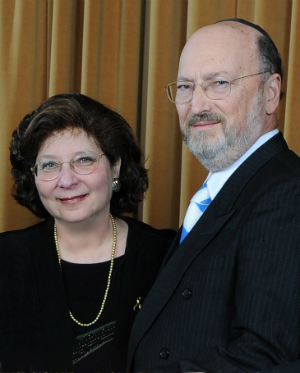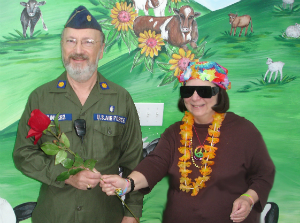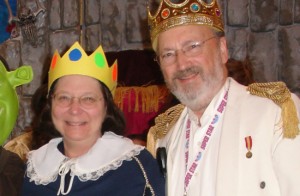 Drs. Peter and Laurel Steinherz are not only married to each other—they’re married to a common calling. For over three decades they’ve worked in tandem, helping cancer patients survive in the face of seemingly impossible odds.
Drs. Peter and Laurel Steinherz are not only married to each other—they’re married to a common calling. For over three decades they’ve worked in tandem, helping cancer patients survive in the face of seemingly impossible odds.
They met at Albert Einstein College of Medicine. He loaned her his textbooks and his dissecting kit—they married soon thereafter. Forty years later, this world-celebrated pediatric oncologist and cardiologist, and founders of Camp Simcha—a life-normalizing getaway for children with cancer—are working together to realize their greatest dream – putting themselves permanently out of business. With volumes of seminal cancer research articles and life-saving breakthroughs between them, they appear to be well on their way.
“People say you shouldn’t sleep on Rosh HaShanah or you’ll have a sleepy (work) year,” says Dr. Peter Steinherz, a pediatric hematologist-oncologist, devoting his life to researching and treating leukemia, lymphoma, and Wilms’ tumor. “I wouldn’t mind a slow year.”
Through all the moments of grief and joy, what remains constant is the Steinherzes unshakable faith. They view their work as a vital partnership with the Ultimate Rofeh. They are diligently fulfilling their end of the deal.
Dr. Peter Steinherz not only manages research and therapies administered to children and adolescents with leukemia at Memorial Sloan Kettering Cancer Center (MSKCC), he also helped develop new treatment protocols considered the standard of care throughout the world. Thanks to his contributions, the survival rate of patients with acute lymphoblastic leukemia–the most common cancer in children—rose from 50 percent in the 1970s to more than 80 percent for high-risk, and more than 90% for standard-risk patients today.
As director of pediatric cardiology at MSKCC, Dr. Laurel Steinherz focuses on the organ pumping the lifeblood her husband treats, evaluating the long-term effects of cancer and cancer therapies on patients’ hearts. Her findings have determined the Children’s Cancer Study Group’s (CCG)[1] procedures for cardiac monitoring of pediatric patients, during and after therapy, which are currently employed across the globe.
Living on cheese sticks and chocolate, the tireless twosome leave their Hewlett, NY home each workday morning at 7:00 and head to Manhattan’s Upper East Side. On average, Peter sees twenty-five to thirty patients in a day, performing spinal taps and bone marrow surgery, and making rounds. When Laurel’s not seeing patients, she’s reading electro-cardiograms and conference calling with national and international medical research groups. The pair finally returns home by 10:00 p.m. But the workday doesn’t stop there. Laurel’s frequently up until 3:00 a.m., going over data and working out drug complications.
 The couple’s cases often overlap. When the MSKCC staff conducts consultations about patients with leukemia, Peter will analyze a drug’s effects on his young patients, and Laurel weighs in on its effects on their hearts. They collaborate on publications and testify together before the FDA on the effects of various drugs. Those closest to them would agree that their renown hasn’t produced any negative effects whatsoever.
The couple’s cases often overlap. When the MSKCC staff conducts consultations about patients with leukemia, Peter will analyze a drug’s effects on his young patients, and Laurel weighs in on its effects on their hearts. They collaborate on publications and testify together before the FDA on the effects of various drugs. Those closest to them would agree that their renown hasn’t produced any negative effects whatsoever.
“They are the humblest people in the world,” says Dr. Leonard Wexler, colleague at MSKCC. “Despite the fact that his cure rates are unmatched anywhere else and she set the guidelines for heart-healthy cancer care.”
Their patients concur. “I knew immediately I wanted Dr. Steinherz to treat me,” says Raffi Leicht, 26, diagnosed with non-Hodgkin’s lymphoma at 21, now in remission. “Because of his knowledge and ability, but also the fact that he is a maamin. [He’s a doctor who] says things like ‘siyata d’Shamaya’ and ‘imertze Hashem.’ That’s a huge deal. And he said repeatedly during my treatments: ‘We’re in this together.’ It wasn’t just a doctor and his patient; it was a Jew and a fellow Jew.”
Jared Okun, 24, diagnosed with lymphoma at 19, also in remission, echoes Leicht’s sentiments. “During our first meeting with Dr. Steinherz my parents started crying. He grabbed a tissue box, handed it to them and then asked me for my Hebrew name,” says Okun. “His colleagues, who were also in the room, saw how important it was to him – to ask me my name for davening before we even spoke about the treatment. It was comforting knowing he understood Who was really in control.”
Dr. Steinherz takes his responsibility to be a mekadesh Hashem seriously. “How you handle crises and tragedies reflects on you as a messenger of Hashem,” says Peter, born during the Holocaust and later smuggled out of Hungary with his family in 1956. “People question why G-d lets these things happen to children. It’s a very difficult thing to accept. While in the trenches, fighting, you don’t know the big picture. Hashem runs the world and it’s beyond human understsanding why tragedies happen. Maybe one day we will.”
Camp Simcha – Summer of Healing
 In 1986, the Steinherzes expanded their protocols to healing the child’s spirit. Rabbi Pinchas Horowitz, son of the Bostoner Rebbe, approached Dr. Steinherz with the idea to launch a project that would help Jewish children with cancer on a spiritual level. Peter proposed opening up a shomer Shabbos summer camp in the Catskills. They were later joined by Rabbi Simcha Scholar, executive director of Chai Lifeline—the umbrella organization providing services for families struggling with serious illness.
In 1986, the Steinherzes expanded their protocols to healing the child’s spirit. Rabbi Pinchas Horowitz, son of the Bostoner Rebbe, approached Dr. Steinherz with the idea to launch a project that would help Jewish children with cancer on a spiritual level. Peter proposed opening up a shomer Shabbos summer camp in the Catskills. They were later joined by Rabbi Simcha Scholar, executive director of Chai Lifeline—the umbrella organization providing services for families struggling with serious illness.
The camp began with twelve children. Today, 220 children, some straight out of the ICU, attend Camp Simcha’s state-of-the-art facility, equipped with an infirmary and medical personnel to administer chemotherapy and g-tube feeds, and a camp staff to administer two glorious weeks of fun.
“Being bald is nothing unusual at camp. Here the children feel normal,” says Peter, Camp Simcha’s medical director. “Overnight, you see them blossom into happy normal children. We see children close to being terminal smiling again.”
According to Rabbi Scholar, Camp Simcha became what it is today because of the Steinherzes nonstop, hands-on dedication. “They deal with illness out in the open,” he says. They don’t ever give up trying everything in their power to make a person better.”
Even if that means getting in on the fun. “They are always the ones to get dressed up and excited over the camp ‘theme of the summer,” says Rivky Schwartz, head counselor of Camp Simcha and Camp Simcha Special for girls. One summer, when the camp dressed up each day according to a Time Machine theme, the Steinherzes walked around the camp, she, decked out in a victorian dress and he, as a knight in shining armor. “The children are drawn to them,” says Schwartz. “The little ones go over and hug them, and the older ones thank them for all they’ve done.”
Originally launched as a summer camp for children battling cancer and other hematological illnesses, Camp Simcha opened a second branch, Camp Simcha Special, for children with debilitating chronic conditions.
Apparently, these dedicated doctors take care of their patients – no matter where they go.
“I’ve watched Peter in shul,” says Rabbi Scholar. “When they make a mishaberach for cholim, out of his mouth comes thirty names – without a list.” Laurel says Tehillim throughout their morning drives to the hospital.
Raised in the ER
Their children will attest—growing up in the Steinherz household was anything but typical, but it was definitely interesting – in an emergency room kind of way.
“I’d ask, ‘Where’s the cream cheese, Mom?’” says Dr. Aviva Oppenheim, of Woodmere, NY—the Steinherzes daughter and a pediatrician in Brooklyn. “She’d answer, ‘To the right of the bio-hazard bag, dear, next to the strep kit,’” Our Shabbos table conversation was basically parsha and the hospital. We felt very much a part of it—they allowed us to be.”
Aviva also got a jump on medical school. “Our house was the triage unit of the neighborhood,” she says. “On Shabbos, there’d be a knock on the door; a boy had gashed his arms through a screen. Instead of running home, he ran to our house. My father stitched him up on the kitchen table.”
While other kids played ball, the Steinherz children played “heart attack.” “My brother would collapse on the floor,” recalls Oppenheim, a doctor at Camp Simcha and one of its first counselors. “I’d run to get my medical emergency crash cart, equipped with a stethoscope, EKG and mock defibrillator, and I’d resuscitate him.” Despite their parents’ jam-packed schedule, no one felt neglected. “They were always there for us,” she says, “My mother was always on top of our home lives; she helped with homework, came to school plays. She worked three days a week, and brought work home, which she did after we went to sleep. I have this vision of her in her doctor’s coat with echocardiogram results pouring out of her pocket and coffee in her hand.”
Dr. Oppenheim appreciates her mother breaking new ground for women in the medical field. “She was one of nine women in her medical school class,” she says. “My class was fifty-one percent women. ‘Work hard, do your best, contribute to Klal Yisrael.’ Those were the big themes growing up in our home. We had a dedicated hospital phone in our home. If that phone rang, everything stopped. It was a huge lesson for us. I knew I needed to serve in an occupation helping people. We didn’t know any other way.” The Steinzerzes three sons—a rav/maagid shiur, a mashgiach ruchani and a kollelman—live in Israel with their families.
Despite the advancements in cancer treatment, not every patient survives. “No one likes to accept defeat,” says Dr. Steinherz. “It’s a tragedy for the family and the physician. It’s tough to bear. I do my best; the rest is up to G-d.”
Nonetheless, they say they’d do it all over again. Decades worth of patients come back to visit, some from as many as thirty-five years ago. Thank you letters and smiling photos of former patients with their children line Peter’s office wall. The Steinherzes rejoice with them at their chatunot, as well as the brissim and bar/bat mitzvot of their children. “That would not have been possible when I started out,” he says.
Tomorrow morning, they’re back on the Van Wyck; Peter’s behind the wheel, Laurel’s behind her Tehillim. After other doctors have long retired, this dynamic duo continues their vital mission. As long as there are sick children, there’s still work to be done.
—
[1] CCG – a U.S. and Canadian clinical trial cooperative group created with the mission of studying childhood cancers.
The words of this author reflect his/her own opinions and do not necessarily represent the official position of the Orthodox Union.
